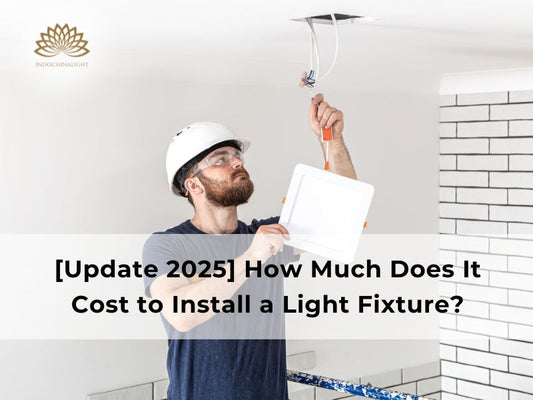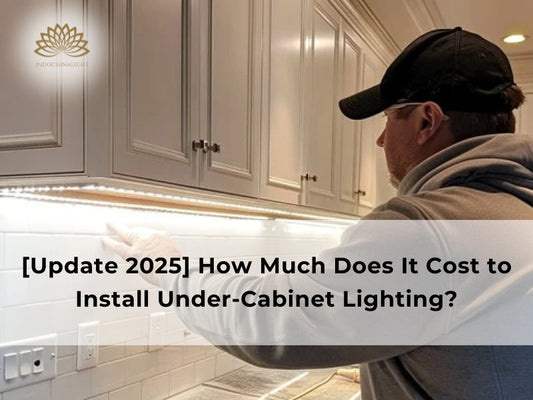How to Calculate the Cost of Installing Recessed Lighting?
Calculate your recessed lighting installation costs accurately by considering these key factors:
- Room size & layout: Measure room square footage and determine light placement. Install one light per 25 square feet for optimal coverage.
- Fixture selection: Choose between standard and LED fixtures. LEDs cost more initially but reduce long-term energy costs.
- Installation costs: Include materials, labor, and additional requirements like wiring or ceiling modifications.
Calculate total cost using this formula: Total Cost = (N × C) + (N × L × I) + A
Where:
- N = Number of fixtures
- C = Cost per fixture
- L = Labor rate
- I = Installation time per fixture
- A = Additional costs
Example: For a 12x12 foot room (144 sq ft). 6 fixtures at $50 each. Labor at $100/hour, 3 hours per fixture. Additional costs of $300 Calculation: (6 × $50) + (6 × 3 × $100) + $300 = $2,400
For those specifically interested in recessed lighting, take a look at the article on how much does it cost to install 4 recessed lights. It focuses on the cost of installing multiple recessed lights, helping you budget accordingly for your project.
Factors Affecting the Cost to Install Recessed Lighting
The main factors influencing the cost of installing recessed lighting include your housing type, ceiling material, trim style, bulb selection, wiring complexity, light placement, permit fees, labor costs, and recessed lighting finish. Understanding these elements helps you plan your project effectively and make informed decisions about materials and installation methods.
Housing Type
The selection of housing type significantly impacts both safety and cost considerations for recessed lighting installation:
- Recessed Lighting IC-rated housing ($7-$100) provides essential safety for installation near insulation, preventing fire hazards and VOC emissions.
- Recessed Lighting Non-IC-rated housing ($6-$90) serves as a cost-effective option for non-insulated areas.
Choose the light housing based on your ceiling structure:
-
Airtight Recessed Lights ($10-$110): These fixtures create sealed barriers between floor levels, maximizing energy efficiency through preventing air leakage. The airtight design maintains consistent room temperatures and reduces energy costs.
-
Shallow Recessed Lighting ($10-$150): For ceilings with limited depth, shallow housing offers a solution where standard 5-6 inch depths aren't feasible. These specialized cans maintain proper lighting while accommodating structural constraints.
-
Canless Recessed Lighting ($15-$130): Modern canless designs eliminate traditional housing, enabling flush mounting directly into ceilings. This streamlined approach creates minimal visual impact while maintaining full functionality.
-
Wet-Rated Recessed Lighting ($20-$100): Essential for moisture-prone areas like bathrooms and outdoor spaces, wet-rated housing provides necessary protection against water damage and electrical hazards.
-
Vaulted Ceiling Recessed Lighting ($20-$75): Specialized housing accommodates angled ceiling installations, ensuring proper alignment and performance on non-flat surfaces.
Ceiling Material
Ceiling composition directly influences installation complexity and cost.
For instance, drywall ceilings offer straightforward installation with optimal cost-efficiency. Complex surfaces like tray or shiplap ceilings require specialized tools and expertise, increasing labor costs. Hard materials such as wood or concrete demand professional-grade cutting equipment and extended installation time, resulting in higher expenses.
If you're considering a general lighting update, it's useful to understand the cost to install light fixtures. This article will provide you with detailed insights into the expenses associated with different types of light fixtures, helping you make an informed decision.
Trim Type
The trim selection impacts both aesthetics and functionality in recessed lighting installations. Different trim types serve specific purposes, from adjustable lighting to moisture protection:
|
Trim Type
|
Cost per Fixture
|
Description
|
| Baffle |
$5 - $80 |
Wide beam, soft glow ideal for living spaces |
| Open |
$5 - $90 |
Basic, economical option |
| Reflector |
$10 - $70 |
Polished finish for focused lighting in kitchens, offices |
| Shower |
$10 - $90 |
Waterproof design for damp areas |
| Wall wash |
$10 - $100 |
Creates wall-highlighting effects |
| Eyeball |
$15 - $90 |
Adjustable for artwork, architectural features |
| Gimbal |
$15 - $60 |
Flexible lighting solution |
| Decorative |
$30 - $100 |
Enhanced finishes like bronze, brushed nickel |
Bulb Type
Bulb selection affects both performance and operating costs. Different types offer varying energy efficiency and light quality:
|
Bulb Type
|
Cost per Bulb
|
Description
|
| Incandescent |
$1 - $5 |
Warm light, shorter lifespan |
| Halogen |
$4 - $15 |
Bright white light, moderate efficiency |
| CFL |
$3 - $15 |
Cool, diffuse light, energy efficient |
| LED |
$5 - $50 |
Highest efficiency, longest life |
| R and PAR |
$6 - $25 |
Focused light for specific areas |
| Smart |
$15 - $60 |
Remote control capability |
Wiring
Wiring lights to the ceiling isn’t always necessary (if you’re working with a ceiling that already has lights, it probably isn’t). If wiring is necessary, choose the material based on the home’s existing wiring:
-
Copper wiring ($0.52–1.25/foot) is common in older homes.
-
Aluminum wiring ($0.26–0.59/foot) is found in newer construction.
These systems can’t be mixed and matched. Simple switch extensions keep costs down, but rewiring the entire system during a renovation can cost anywhere from $4,000 to $10,000. The complexity of the installation and the existing infrastructure determine the final cost of the wiring.
If you’re planning to install a more intricate lighting option, such as a chandelier, you might want to know the cost to install chandelier. This article explores the factors influencing chandelier installation and the typical costs involved.
Light Location
Electricians charge more for recessed lighting in areas with obstacles like joists, heat ducts, or electrical wiring. If these barriers exist, expect an extra $200 per light for rerouting or adjustments. Labor expenses differ based on the room and its particular location within a home.
|
Location
|
Estimated labor cost in new build
|
Estimated labor cost in an existing one
|
Description
|
| Bathroom |
$275 - $375 |
$725 |
Installing fixtures in bathrooms can often be pricier because they require specialized options like IC-rated or airtight lights, along with the fact that the spaces are usually smaller and more difficult to work in. |
| Kitchen/Dining room |
$250 - $350 |
$450 - $650 |
The installation expenses may be higher because of the requirement for accurate positioning, the existence of appliances and cabinets, as well as any extra decorative lighting features. |
| Living room |
$200 - $300 |
$450 - $650 |
High ceilings and a sophisticated lighting design, especially with elaborate patterns or spacious areas, demand additional labor. |
| Bedroom/Hallway |
$100 - $200 |
$725 |
The installation expenses are usually more affordable because the process is quite simple. However, costs may rise if you're opting for a tray ceiling or features like dimmable or smart lighting. |
Permits
A permit is not needed when replacing an old fixture with recessed lighting, but if a new circuit is installed, approval is required due to electrical system modifications. Depending on local building codes and project complexity, permit costs range from $50 to $500. Municipal fees vary, and larger installations often demand higher charges. Licensed electricians, if registered with the city, can assess whether a permit is necessary during an initial site evaluation.
Labor
Hiring an electrician to install recessed can or canless LED lights typically costs $200 to $250 per fixture. Rates depend on the project's complexity and regional labor pricing. Professionals charge between $85 and $105 per hour, with installation taking two to three hours per light. Factors like ceiling height, existing wiring, and access points can impact labor time and final costs.
Choosing a skilled electrician ensures safe wiring, code compliance, and efficient placement. While DIY installation may seem cost-effective, improper wiring can lead to electrical hazards and expensive repairs.
Recessed Lighting Finish Type
Finish selection affects both cost and aesthetics:
|
Finish Color
|
Cost per Piece
|
Description
|
| White |
$5 - $20 |
Standard option, blends with ceilings |
| Black |
$10 - $25 |
Contemporary contrast element |
| Brushed Nickel |
$15 - $40 |
Safe for insulation contact |
| Bronze |
$20 - $50 |
Traditional/rustic appeal |
| Chrome |
$20 - $45 |
High-gloss polished appearance |
| Copper |
$25 - $60 |
Premium craftsmanship |
| Custom |
$25 - $100 |
Exact interior match |
| Gold |
$30 - $80 |
Specialized premium finish |
Additional Recessed Lighting Installation Costs
Additionally, there are additional considerations that impact total installation costs such as: type of construction, drywall repair, indoor vs. outdoor installation location, customization, and site accessibility. Each of these factors significantly impacts the final project cost.
New Construction vs. Ceiling With Pre-Existing Lights
Recessed lighting installation is more affordable when replacing existing fixtures, as wiring and cutouts are already in place. Costs range from $200 to $300 per light, with a full project totaling $800 to $2,160, depending on the number of fixtures.
Installation is more labor-intensive for new ceilings, requiring cutting drywall, running new wiring, and securing fixtures. This raises costs to $500 per light and $800 to $2,880 for a complete setup.
Drywall Repairs
Existing home installations often require drywall modifications. Repair costs range from $300-$900, with recessed lighting typically falling at the lower end. These repairs ensure seamless integration with existing ceiling surfaces.
Indoor vs. Outdoor Lighting
Outdoor recessed lighting generally costs more than indoor installations due to limited placement options and additional electrical work. Outdoor setups often require weatherproof wiring, sealed housings, and higher-grade materials to withstand environmental elements.
Despite the higher cost, fewer fixtures are needed to adequately illuminate outdoor spaces than indoor spaces. Prices for outdoor recessed lighting range from $300 to $550 per fixture, while indoor installations typically cost $100 to $480 per light, depending on wiring complexity and ceiling type.
Customizations
Adding custom features to recessed lighting enhances functionality and convenience but increases costs. Dimmer switches, which allow precise brightness control, cost around $125 to install. This feature lets you adjust lighting for different moods, improving ambiance and energy efficiency.
For a more integrated system, homeowners can install a wall panel with multiple switches, including standard and dimmer options, providing centralized control over lighting. Depending on features and wiring complexity, wall panels typically range from $50 to $100.
These upgrades improve usability and add modern aesthetics and flexibility to your lighting setup, making them valuable additions for those seeking enhanced control.
DIY Recessed Lighting Installation vs. Hiring a Pro
Installing recessed lighting as a DIY project can cut costs by 50% compared to hiring a professional. If an electrician charges $100 per fixture, doing it yourself costs around $50, covering essential materials like housing, trim, and wiring components. The final expense depends mainly on the type of light fixture used rather than labor fees.
Hiring a pro ensures code compliance, proper wiring, and a seamless finish, but labor costs range from $85 to $105 per hour, with each light taking at least two hours to install. DIY installation eliminates labor fees but requires electrical knowledge, precise measurements, and safety precautions.
While a DIY approach saves money, hiring an expert reduces installation risks and potential future repairs, making it a choice between cost-efficiency and professional quality.
Installing a ceiling light without existing wiring requires additional work and costs. To get a clearer idea, check out the article on ceiling lights installation cost, which covers the costs associated with such installations.
How to Save on Recessed Lighting Installation
Smart planning and strategic decisions can significantly reduce recessed lighting installation costs. Consider these six money-saving approaches while maintaining quality and safety standards:
-
Choose the right type of recessed lights: LED recessed lights have a higher upfront cost but are energy-efficient and long-lasting, reducing replacement and electricity expenses. Opting for standard trims and housings instead of custom or decorative designs helps lower costs while maintaining aesthetic appeal.
-
Plan your layout carefully: Strategic light placement ensures maximum coverage with fewer fixtures, minimizing costs. Using existing wiring whenever possible also reduces electrical work, avoiding unnecessary expenses.
-
DIY installation where possible: Homeowners can handle simple tasks like marking fixture locations, cutting ceiling holes, and cutting labor costs. Those with electrical knowledge can install lights but must follow local safety codes.
-
Hire the right professional: If hiring a pro, research licensed electricians with fair rates and positive reviews to ensure quality work at the best price.
-
Timing matters: Installing recessed lights during construction or major renovations is cheaper than retrofitting. Bundling installation with other electrical projects can also reduce overall labor costs.
-
Take advantage of rebates and discounts: Many utility companies offer rebates for energy-efficient LED lighting. Watching for holiday or seasonal sales on fixtures and materials can also result in significant savings.
Conclusion
This comprehensive guide provides a detailed cost analysis for 2025 recessed lighting installation. From basic fixtures to complex systems, understand material costs, labor rates, and potential savings. Topics covered include installation factors, housing types, trim options, and cost-saving strategies.
If you're replacing an old light fixture, the replace light fixture cost article is a helpful resource. It outlines the expenses involved in removing and replacing light fixtures, offering guidance on how to budget for the replacement process.
IndochinaLight offers expert guidance for your lighting projects. Browse our extensive collection of modern lighting solutions designed for style and functionality.
IndochinaLight - IndochinaHomeDecor LLC
- Address: 30 N Gould St Ste. N, Sheridan, WY 82801
- Phone: (+)1 307 249 0594
- Email: service@indochinalight.com
Frequently Asked Questions (FAQs)
How much does it cost to install 4 recessed lights?
Installing four recessed lights typically costs between $520 and $1,200, with each light averaging around $130 to $300 including both materials and labor, depending on the quality of fixtures, local labor rates, and the complexity of the installation.
How many recessed lights do I need for a 12x12 room?
A 12x12 room typically requires 6 recessed fixtures (600 lumens each). Final count depends on room layout, ceiling height, and desired illumination level. Consider task areas and ambient lighting needs when planning.
How much does an electrician charge to install ceiling lights?
Basic fixture installation costs $75-$300, with complex installations reaching $1,000+. Rates vary by location, electrician expertise, and project requirements. Additional wiring or circuit installation increases costs.
How long does it take to install 6 recessed lights?
Each fixture requires 30-60 minutes for installation. The time varies based on wiring accessibility and ceiling construction. The total project duration is 3-6 hours for professional installation.
How much does it cost to install recessed lighting in finished ceiling?
Finished ceiling installation costs $200-$400 per light. This includes cutting ceiling access, wiring installation, and drywall repair. Complex installations or premium fixtures increase the total project cost.
What is the best alternative to recessed lighting?
Alternatives to recessed fixtures include semi-flush mounts, pendants, track lighting, disc lights, wall sconces, LED panels, and floor lamps. Each offers unique aesthetic and functional benefits.
What are the disadvantages of recessed lighting?
The primary disadvantages of LED lighting are complex installation requirements, higher costs, and limited light coverage. These factors should be considered when planning lighting projects.
Can you have too much recessed lighting?
Yes, but excessive recessed lighting can create harsh illumination and visual discomfort. Proper spacing and quantity prevent over-illumination issues.
How far apart should 4-inch recessed lights be spaced?
For optimal coverage, space 4-inch recessed lights 4-5 feet apart. This spacing ensures even illumination and minimizes shadowing.
Can I install recessed lighting myself?
DIY installation is possible with electrical knowledge and proper power access—professional installation is recommended for safety and code compliance.









